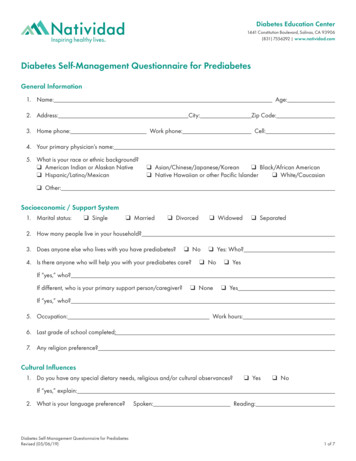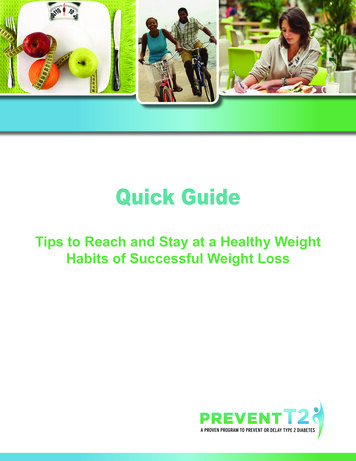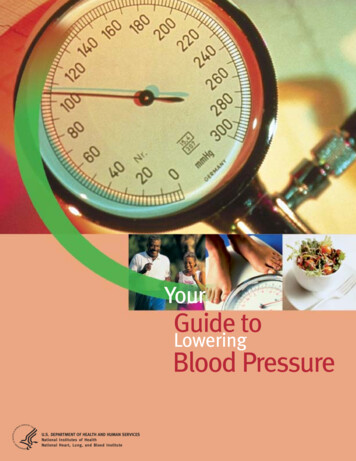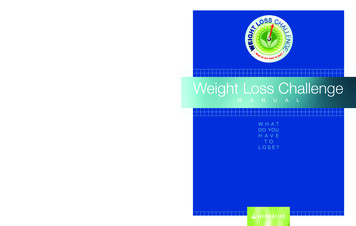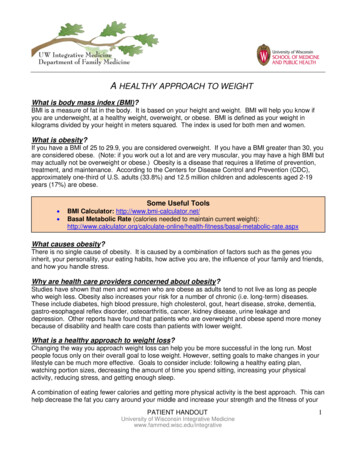
Transcription
A HEALTHY APPROACH TO WEIGHTWhat is body mass index (BMI)?BMI is a measure of fat in the body. It is based on your height and weight. BMI will help you know ifyou are underweight, at a healthy weight, overweight, or obese. BMI is defined as your weight inkilograms divided by your height in meters squared. The index is used for both men and women.What is obesity?If you have a BMI of 25 to 29.9, you are considered overweight. If you have a BMI greater than 30, youare considered obese. (Note: if you work out a lot and are very muscular, you may have a high BMI butmay actually not be overweight or obese.) Obesity is a disease that requires a lifetime of prevention,treatment, and maintenance. According to the Centers for Disease Control and Prevention (CDC),approximately one-third of U.S. adults (33.8%) and 12.5 million children and adolescents aged 2-19years (17%) are obese.Some Useful ToolsBMI Calculator: http://www.bmi-calculator.net/Basal Metabolic Rate (calories needed to maintain current /health-fitness/basal-metabolic-rate.aspxWhat causes obesity?There is no single cause of obesity. It is caused by a combination of factors such as the genes youinherit, your personality, your eating habits, how active you are, the influence of your family and friends,and how you handle stress.Why are health care providers concerned about obesity?Studies have shown that men and women who are obese as adults tend to not live as long as peoplewho weigh less. Obesity also increases your risk for a number of chronic (i.e. long-term) diseases.These include diabetes, high blood pressure, high cholesterol, gout, heart disease, stroke, dementia,gastro-esophageal reflex disorder, osteoarthritis, cancer, kidney disease, urine leakage anddepression. Other reports have found that patients who are overweight and obese spend more moneybecause of disability and health care costs than patients with lower weight.What is a healthy approach to weight loss?Changing the way you approach weight loss can help you be more successful in the long run. Mostpeople focus only on their overall goal to lose weight. However, setting goals to make changes in yourlifestyle can be much more effective. Goals to consider include: following a healthy eating plan,watching portion sizes, decreasing the amount of time you spend sitting, increasing your physicalactivity, reducing stress, and getting enough sleep.A combination of eating fewer calories and getting more physical activity is the best approach. This canhelp decrease the fat you carry around your middle and increase your strength and the fitness of yourPATIENT HANDOUTUniversity of Wisconsin Integrative Medicinewww.fammed.wisc.edu/integrative1
A Healthy Approach to Weightheart and lungs. Initially, plan to lose about 5-10% of your body weight. (For example, if you weigh250 pounds, multiply this number by 0.10 25 pounds 10%).This amount can make a big differencein your health. You can continue to lose more as needed.People lose weight at different paces. It is important to keep your expectations realistic. Aim to loseone to two pounds per week for a period of six months (depending on how much weight you need tolose). Don’t give up. Women, in particular, have difficulty losing more than one pound per week. Inorder to lose one pound of weight per week, you need to eat 3500 fewer calories per week or burn upthat many calories through exercise. A nutritionist can help develop a plan just for you, finding ways toeliminate 500 to 1,000 calories per day.A healthy approach to weight loss will include some or all of the following approaches: 1) good nutrition,2) diet or weight loss programs, 3) exercise and movement, 4) supplements and herbs, 5) medicationreview, 6) mind-body therapy, 7) adequate sleep, and 8) acupuncture and hypnosis.PATIENT HANDOUTUniversity of Wisconsin Integrative Medicinewww.fammed.wisc.edu/integrative2
A Healthy Approach to Weight1. NutritionFor a healthy diet:Eat mostly plants. You can decrease your risk for many diseases byeating 8-10 servings of fruits and vegetables each day. When possible,buy organic products that were grown in your area. (See our handoutProtein Alternatives to Meat.)Eat 20-35 grams of fiber daily.Choose a variety of whole grains and aim for carbohydrates low in glycemic index. Theglycemic index of a food refers to the effect the food has on the body’s blood sugar levels.(See our handout Glycemic Index & Glycemic Load for more information.)Limit fat. Keep fat between 25-35% of your total calories. Especially limit saturated fats. Avoideating trans-fatty acids (e.g., hydrogenated vegetable oils found in margarines, commerciallyfried and baked foods.)Eat little sugar. Eat natural sugars only in small amounts. Avoid artificial sweeteners.Eat little salt. Choose and prepare foods with less salt. Aim for no more than 2,400 mg of saltper day. This is about one teaspoon.Eat more omega-3 fatty acids. Omega-3 fatty acids reduce inflammation and risk for heartdisease. You can get these fatty acids from eating fatty cold water fish, walnuts, ground flaxseed, and fortified eggs. (See our handouts Omega-3 Fats and The Anti-Inflammatory Diet formore information.)Drink more fluids! Most adults need about two liters of fluid per day. This is about 8½ cupsper day. Many people eat when their bodies are actually giving them cues to drink. Be carefulnot to drink calories. Filtered water and green tea are good choices.Eat smart. Try to eat around the same time each day. Be careful to control the size of yourportions.Eat only when hungry. Pay attention to how your body feels. Stop eating when full.Additional Reading on NutritionEat, Drink, and Be Healthy: The Harvard Medical School Guide to Healthy Eating byWalter Willett. New York: Free Press. (2005)Eat, Drink, & Weigh Less by Mollie Katzen and Walter Willett. New York: Hyperion. (2007)Superfoods Healthstyle by Steven Pratt and Kathy Matthews. New York: William Morrow.(2006)Eating Well for Optimal Health by Andrew Weil. New York: Alfred A. Knopf, Inc. (2000)Food Rules by Michael Pollan. New York: Penguin Books. (2009)Sugar CravingsWe know that people can become addicted to alcohol or caffeine. It is not as well known that manypeople are addicted to refined sugar. Reactive hypoglycemia is a condition that involves a huge fallin sugar levels in the blood. This condition occurs when the body releases a large amount of insulinto counteract the effects of a meal containing a lot of carbohydrates (starches) or sugar.One of two things can happen when blood sugar levels drop in the body. If the blood sugar levelsdrop too fast, the body compensates by releasing adrenaline and other hormones to raise bloodsugar levels. This results in a stress reaction, the “fight or flight response.” Symptoms can include:anxiety, panic, hunger, heart palpitations, rapid heartbeat, tremors, sweating, and stomach pain. IfPATIENT HANDOUTUniversity of Wisconsin Integrative Medicinewww.fammed.wisc.edu/integrative3
A Healthy Approach to Weightthe blood sugar levels fall slowly over a matter of hours, you can have a headache, fatigue andmemory problems. Symptoms of reactive hypoglycemia tend to occur or become worse in the latemorning and late afternoon. It can also occur if a meal is missed. If you develop these symptomsand if they go away when you eat, you may have reactive hypoglycemia.People who have reactive hypoglycemia frequently crave refined sugar or other carbohydrates.Eating these foods may provide temporary relief from symptoms. However, eating more sugar andstarch tends to trigger another episode of hypoglycemia and carbohydrate cravings. This cyclecan lead to overeating and obesity.The symptoms of reactive hypoglycemia including the sugar cravings can be managed by makingchanges in the way you eat. If you have reactive hypoglycemia, you will feel best and have lessrebound hunger if you eat several small meals and healthy snacks throughout the day. Eat nomore than three hours apart. It is also important to eat a well-balanced diet. Include plant sourcesof protein, complex carbohydrates (those with a low glycemic index), and fruit and vegetables. (Seeour handouts Protein Alternatives to Meat and Glycemic Index and Glycemic Load for moreinformation.) It is best to avoid or limit foods with high sugar content, especially on an emptystomach. These include refined sugars as well as natural sugars such as fruit juice, honey, andmolasses. Keep alcohol to a minimum, and always eat food while you drink alcohol. When youmake these changes to your diet, you may have withdrawal symptoms for two to three days untilyour body controls blood sugar levels normally again.2. Diet and Weight Loss ProgramsThere are dozens of diets available for weight loss. In general, most diets work because a personeats less while on the diet. Some diets work better for some patients, however. For example, a lowcarbohydrate diet might be helpful for someone whose body has difficulty regulating blood sugars(high triglyceride cholesterol). A low fat diet might be helpful for someone who has high cholesterol(high LDL cholesterol). A dietician can help you determine which diet is best for you.Low carbohydrate dietso The Atkins diet (www.atkins.com) is a high-fat, low-carbohydrate diet. The thought is toreduce carbohydrates, which can increase insulin levels and start chemical changes thatcause weight gain.o The South Beach diet (www.southbeachdiet.com) is a spin-off of the Atkins diet. TheSouth Beach diet allows "good" carbohydrates—those with a lower glycemic index. It istherefore more balanced than the Atkins diet.Low fat dietso The Ornish Diet (www.ornishspectrum.com) is a low fat, high fiber, vegetarian diet. Ithas been proven to prevent and reverse heart disease, in addition to helping with weightloss.Balanced Dietso The Zone diet (www.drsears.com) uses a "40-30-30" rule. The diet consists of 40%carbohydrates, 30% protein, and 30% fat. It includes very few grains and starches. Theidea is that a balance of carbohydrates, proteins, and fats keeps insulin levels "in thezone." It is believed the diet will help prevent fat storage and inflammation in the body.This has not yet been proven.PATIENT HANDOUTUniversity of Wisconsin Integrative Medicinewww.fammed.wisc.edu/integrative4
A Healthy Approach to WeightooThe Weight Watchers (www.weightwatchers.com) approach helps members to loseweight by promoting new eating habits, eating smarter, getting more exercise andproviding support. A point system for food is used. Members are usually encouraged toeat 1000 calories less each day than they usually eat. Both local support groups andon-line programs are available.The Anti-Inflammatory Diet. A number of medical conditions are linked to too muchinflammation in the body. These include heart disease, stroke, cancer, asthma, diabetesmellitus type 2, chronic pain, inflammatory bowel disease and Alzheimer’s disease. It isa good idea for any long-term, healthy eating plan to include guidelines of the AntiInflammatory Diet. These include: 1) avoiding unhealthy fats, 2) eating more good fats,3) aiming to eat 8-10 servings of fruits and vegetables each day, and 4) eating at least30 grams of fiber daily, choosing whole grains whenever possible. (See our handout TheAnti-Inflammatory Diet for more information)According to members of the National Weight Control Registry, who have been successful withweight loss, keeping a log of the food eaten each day and weighing oneself regularly havebeen very helpful for weight loss planning and helping to keep the weight off.On-Line Programs and Applications (“Apps”) To Record Food and Physical ActivityCalorie Count: http://caloriecount.about.com/ or http://www.myfitnesspal.com/ .SuperTracker through the United States Department of Agriculture efault.aspx3. Exercise and MovementPhysical activity is an important part of weight loss and weight control.Increasing physical activity can help you lose weight if you are overweight orobese. It may decrease belly fat. It increases the fitness of the heart andlungs. And it may help you keep the weight off, once you lose it.Being physically active for at least 150 minutes per week will help you behealthy and fit. You likely will need to be more active than this to help withweight loss. According to the National Weight Control Registry, to lose weighta person needs to exercise for about 60 minutes per day. This will burnaround 400 calories a day. To keep the weight off once you lose it, exercise60-90 minutes per day.C. LuchterhandUW Integrative MedicineSmall changes in physical activity can add up over time. Walk or bike rather than drive. When youdrive, park farther away from an entrance. Take the stairs when possible. You may find it helpful touse a pedometer to count the steps you take during the day. Usually, 10,000 steps per day (fivemiles) are recommended. Your health practitioner can help set a goal that is right for you. Exerciseis very important, but please remember that most weight loss occurs by improving your nutrition andeating fewer calories.4. Supplements/HerbsThere are a large number of supplements that are marketed for weight loss. Research, however,has found few of them to be both safe and effective.PATIENT HANDOUTUniversity of Wisconsin Integrative Medicinewww.fammed.wisc.edu/integrative5
A Healthy Approach to WeightThe following supplements are safe and may be helpful while you are losing weight.Multivitamin. Food cravings can be triggered by the body's lack of a certain vitamin or mineral.Taking a daily multivitamin reduces the likelihood of deficiency and may help with cravings.Fiber. Studies have shown that eating fiber can help prevent and manage obesity. Plus, eatingmore fiber is safe and improves your health in many other ways. Fiber can lower your risk ofdeveloping heart disease, stroke, high blood pressure, and diabetes. It also lowers cholesterol,improves blood sugar levels in diabetes, and promotes regular bowel movements. Fibersupplements can help increase the amount of weight you lose if you are obese. Foods high infiber usually have a lower glycemic index and will help you feel less hungry. Try to eat 20-35grams of fiber each day. If you are not able to get this much fiber through your diet, you cantake fiber supplements. These include: psyllium, guar-gum, methyl cellulose or ground flaxseed. Take one tablespoon in 8-10 ounces of water daily or one teaspoon in six to eight ouncesof water before each meal.Camellia sinensis (green tea). A review of 15 well-designed studies involving 1226 peoplefound green tea to be effective for weight loss and for keeping the weight off. Doses included270-1207 milligrams per day. (250 milligrams of green tea extract 1 cup). A more recentresearch review showed that green tea may modestly reduce BMI, body weight, and waist size.The bottom line is that using green tea for weight loss is unlikely to be harmful, and it appears tohave a small benefit in weight loss.The following supplements are found in commercial weight loss products. There is no data to provethat most of them are safe and effective. Some of them are known to be unsafe. We do notrecommend them for weight loss.SUPPLEMENTSEphedraChromium picolinateConjugated Linoleic AcidChitosanHoodiaBitter OrangeGlucomannanGarcinia (hydroxycitric acid)L-CarnitinePyruvateGinsengGuar gumPsylliumGreen teaSt. John’s WortEFFICACYEffectiveNot likely effectiveNot likely effectiveNot likely effectiveNot likely nNot effectiveUnknownUnknownUnknownPATIENT HANDOUTUniversity of Wisconsin Integrative Medicinewww.fammed.wisc.edu/integrativeSAFETYNot safeUnknownUnknownSafeUnknownNot safeSafeUnknownSafeSafeUnknownSafeSafeSafeUnknown6
A Healthy Approach to Weight5. MedicationsOrlistat is the only medication approved by the U.S. Food and Drug Administration (FDA) for longterm use to treat obesity. It works by preventing the body from absorbing fat. Diarrhea is a sideeffect if a person eats fat while on it and also lacks important vitamins in the body. Drug treatmentof obesity can be helpful in the short-term. Unfortunately, rebound weight gain occurs for manypeople after the drug is stopped.Occasionally medications that are used to treat other conditions cause weight gain. It is not alwayspossible to change therapies. However, if you are trying to lose weight, you might want to checkwith your health care practitioner to learn if any medications you take may be contributing to weightgain. Medications that may promote weight gain include: tranquilizers; drugs used to treatdepression, diabetes, heart disease and those that prevent allergic reactions and seizures.6. Mind-Body ApproachesCounseling. Research has shown that regular visits with a physician or dietician while you arelosing weight can help you stay on track. These visits are particularly important if you have amental health issue (such as depression) that affects the amount you eat.You may also want to consider cognitive behavioral therapy (CBT). CBT is a form ofpsychotherapy that focuses on how you think. It is based on the idea that your feelings andbehaviors are influenced by your own thoughts, not by other people or situations. This therapycan help you change the way you think about whatever is bothering you. You may then feelbetter and perhaps eat less, even if the situation has not changed. Psychologists and clinicalsocial workers provide CBT.Mindful Eating. Your eating patterns can contribute to your weight. It isimportant to pay attention to when you eat, how much you eat, and the typeof food you eat. The practice of mindfulness is often used to reduce stress.It has also shown promise to help those desiring weight loss. Throughmeditation and yoga, you can develop an increased awareness of yourbody. This awareness can help you realize when you are full and when youeat for reasons other than hunger.Mindful eating is the idea that you can take control of what you put in yourbody and get pleasure from eating the foods you choose. The nature of ourStuart MilesFreeDigitalPhotos.netsociety is such that people often let eating get out of our control for onereason or another. We eat quickly so that we can get back to work. We eat fast food because itis convenient and quick. We eat at restaurants because we are too tired or busy to cook forourselves. We eat processed food because it is cheaper and more available than fresh produce.Sometimes we eat foods that provide less nutrition because they taste good and give us animmediate burst of energy. Bodies are hard-wired to like sugar and fat. However, because ofthe way we eat, we often do not even notice or enjoy the flavors of our food. (See our handoutMindful Eating for more information.)Internet Resources on Mindful EatingThe CAMP System: The Joy of Mindful Eating: http://www.mindfuleating.org/The Center for Mindful Eating: www.tcme.orgPATIENT HANDOUTUniversity of Wisconsin Integrative Medicinewww.fammed.wisc.edu/integrative7
A Healthy Approach to WeightMindful Eating ExerciseApproach food with a desire to experience all it has to give you.Take the time to be aware of every sensation you get from each piece of food.Start with how you feel before you eat--notice how hungry or full you are, andwhat made you choose the food you are eating.Notice how the food looks--the color, textures, and arrangement on your plateand how the food smells.Take a single bite and focus on the sensation as it hits your tongue--thetemperature, texture, and initial taste.Continue to focus on that single bite, chewing carefully and appreciating eachsensation as it comes to you.When you are finished with that bite, pause to reflect on what emotions orthoughts you have about the food and about what pleasure you got from it.Wait to pick up another bite of food until you take that reflective pause.Start all over with the next bite, and continue to be aware of your food in all ofthose ways.Additional Reading on Mindful EatingWomen, Food and God by Geneen Roth. New York: Scribner. (2010)Savor: Mindful Eating, Mindful Life by Thich Nhat Hanh and Lilian Cheung. NewYork: HarperOne. (2010)Eating Mindfully: How to End Mindless Eating and Enjoy a BalancedRelationship with Food by Susan Albers. Oakland, CA: New HarbingerPublications, Inc. (2003)Overeaters Anonymous is a 12-step program to address uncontrolled eating. It addressesphysical, emotion and spiritual well-being. More information including how to find a localchapter is at http://www.oa.org/.Stress Management. Bodies respond to stress—the pressure you feel from variouscircumstances in your life. When stressed, you won’t feel centered or balanced. Your body canreact in various ways. Part of this response to stress involves chemical changes in the bodythat can increase belly fat and make it difficult to control sugar levels in the blood. Stress mayalso affect the foods you choose to eat. If you are stressed, you may have less time to preparehealthy food. During this time, you may also prefer higher-fat foods. And you may decrease theamount of physical activity you do. In all these instances, you can easily eat too many caloriescompared to what you need.To give yourself the best opportunity to succeed at losing weight, develop a plan for how youcan reduce the stress in your life. You will find some excellent ways in our handouts BreathingExercise, Using Journaling to Aid Health, and Meditation for Health and Happiness. There aremany other helpful approaches such as hobbies, music (either performing or listening), physicalactivity, yoga, spending time in nature or with companion animals.PATIENT HANDOUTUniversity of Wisconsin Integrative Medicinewww.fammed.wisc.edu/integrative8
A Healthy Approach to Weight7. SleepResearch has shown that getting too little sleep contributes to obesityfor both children and adults.Getting four hours of sleep or less per night affects the body’snervous system and increases the amount of a hormone, cortisol, thatthe body makes in the evening. This can lead to your eating more andadding belly fat. Sleeping too little also leads to lower levels of leptin.Leptin is made by fat cells. It sends messages to the hypothalamusDavid Castillo Dominici(the brain center for hunger). As leptin levels decrease, theFreeDigitalPhotos.nethypothalamus thinks that the fat cells need more food. You then willfeel an urge to eat more. A third issue is that too little sleep can lead to an increase in ghrelin. Thisis a hunger hormone made in the stomach. Higher ghrelin levels will increase your hunger, andagain you may eat too much. Sleeping fewer hours also means that you will have more hours in aday to eat, resulting in over-eating.People who work different shifts are at higher risk than others for obesity and other conditionsrelated to eating and energy. This might be because they do not eat at regular times and may eatless healthy food. Other reasons may include stress, disrupted sleep-wake cycles, and not gettingenough physical activity, relaxation or sleep. There is increasing research that shows that the timeof day one eats, how often and how regularly one eats, and disrupted sleep-wake cycles may affecthow the body converts food to energy and regulates weight. Some ways to cope with this include:1) limit shift work when possible, 2) go to bed at the same time each night and get seven to eighthours of sleep, 3) limit night-time eating, 4) eat regular meals, 5) eat breakfast.Sleep recommendations from theAmerican Academy of Sleep MedicineInfants (3 to 11 months): 14 to 15 hoursToddlers: 12 to 14 hoursPreschoolers: 11 to 13 hoursSchool-age children: 10 to 11 hoursAdults: 7-8 hours8. Other ApproachesAcupuncture. It has been observed that acupuncture tends to decrease appetite. Althoughmany studies have looked at the relationship between acupuncture and weight loss, most werenot well done. So, there is no proof that acupuncture helps in this way. You may want to tryacupuncture for weight loss, since it involves little risk.Hypnosis. Two careful reviews looked at the results of a number of studies on hypnosis forweight loss. They found that people who received both hypnosis and cognitive behavioraltherapy (CBT) lost more weight than those who had CBT only. Another study compared threegroups: 1) hypnosis to reduce eating, 2) hypnosis to reduce stress, and 3) dietary advice alone.After three months, all three groups lost two to three percent of their body weight. By 18 months,only the group who received hypnosis to reduce stress reduction had kept weight off. Thisevidence suggests that hypnosis may be a useful treatment for obesity.PATIENT HANDOUTUniversity of Wisconsin Integrative Medicinewww.fammed.wisc.edu/integrative9
A Healthy Approach to WeightSample Weight Management PlanHere is an example of lifestyle changes you can make to help lose weight.Week 1 Ask yourself What has contributed to my weight problem?What changes am I ready and committed to make? Consider writing a healthy weight mission statement for yourself. (See page 11 of this handout.) Learn the practice of mindful eating. (See pages 7-8 in this handout and our handout MindfulEating.) Explore your relationship with food. Start keeping a log of the food you eat each day. Explore your relationship with your body as it is now. Consider journaling. (See our handoutUsing Journaling to Aid Health.)What is working well?What would you like to improve?Week 2 Ask yourself How much sleep am I getting each night?Is there anything that is interfering with good sleep?Identify ways to get enough good quality sleep. Meet with a dietician to create a diet that will help you lose one pound of weight per week. Go through your pantry. Give or throw away any food that is not nourishing your health. Brainstorm ways to sit less. Consider using a pedometer.Week 3 Make time to exercise each day. If you are not exercising now, set realistic goals for a physicalactivity that you enjoy. If you are currently exercising, increase the amount of time you exercise.Try for 60 minutes most days of the week. Consider seeing an exercise physiologist or personaltrainer if you already exercise this amount. Ask this specialist to help you increase the efficiencyof your workouts.Week 4 Start drinking green tea. Take a fiber supplement before meals. (See page 6 of this handout.) Focus on stress reduction. What do you do to release stress and relax? Consider acupuncture or mind-body therapies including counseling and hypnosis. (See pages7-9 of this handout.)Week 5 Continue the lifestyle changes you made above. Schedule an appointment with your health care professional every month for six months for aweight check. Then schedule an appointment every six months until you both decide that youare able to keep the weight off. This is especially helpful if your weight loss goal is greater than30 pounds.PATIENT HANDOUTUniversity of Wisconsin Integrative Medicinewww.fammed.wisc.edu/integrative10
A Healthy Approach to WeightMy Mission Statement for Healthy Weight and Wellbeing(from Savor: Mindful Eating, Mindful Life by Thich Nhat Hanh and Lilian Cheung.Through being more mindful and paying more attention to my health and wellbeing, I will lose(number) pounds by (date) and keep it off over the following year and beyond.Beginning goals to help me reach my desired weight:(date)I will practice some mindfulness every day with the goal of increasing the amount each week.I will walk at least 5,000 steps (measured by pedometer) or half an hour every day andslowly increase this each week until I reach 10,000 steps per day or one hour per day.I will buy more fruits and vegetables.I will not buy sugary beverages or soda.I will avoid all processed food.The information in this handout is for general education. It is not meant to be used by apatient alone. Please work with your health care practitioner to use this information in thebest way possible to promote your health.References, if needed, can be found in the clinician version of this handout.This handout was created by Jackie Redmer MD, MPH, Integrative Medicine Fellow, and CharleneLuchterhand MSSW, Integrative Medicine Education/Research Coordinator, adapted from a handoutwritten for clinicians by Jackie Redmer MD, MPH. Both are in the Department of Family Medicine atthe University of Wisconsin-Madison School of Medicine and Public Health.Date created: March 2012Notes:PATIENT HANDOUTUniversity of Wisconsin Integrative Medicinewww.fammed.wisc.edu/integrative11
o The Zone diet (www.drsears.com) uses a "40-30-30" rule. The diet consists of 40% carbohydrates, 30% protein, and 30% fat. It includes very few grains and starches. The idea is that a balance of carbohydrates, proteins, and fats keeps insulin levels "in the zone." It is believed the diet wi



